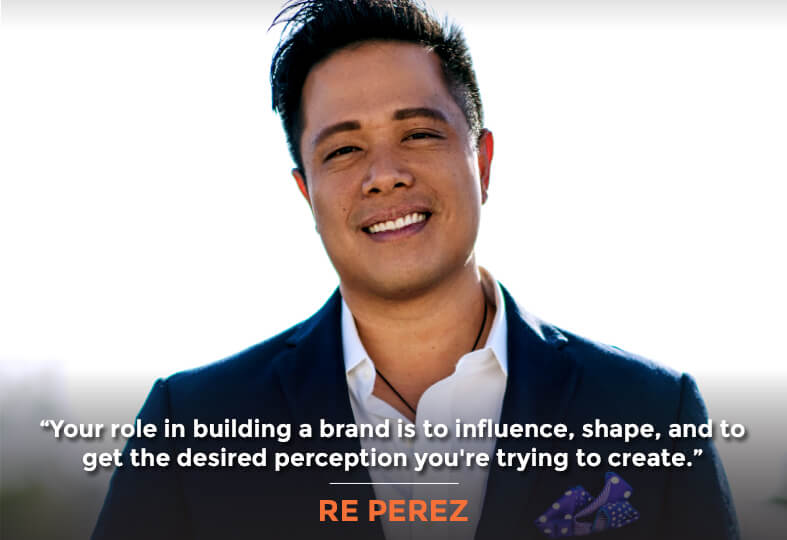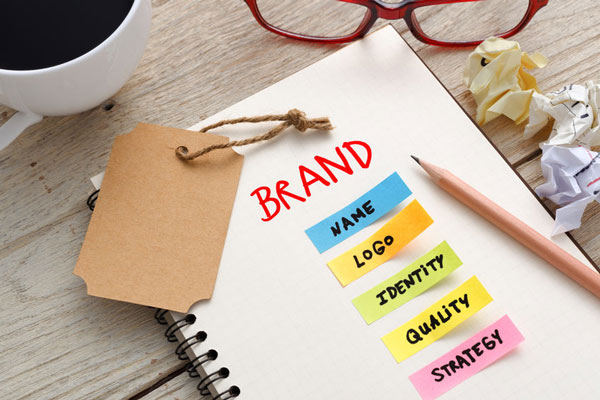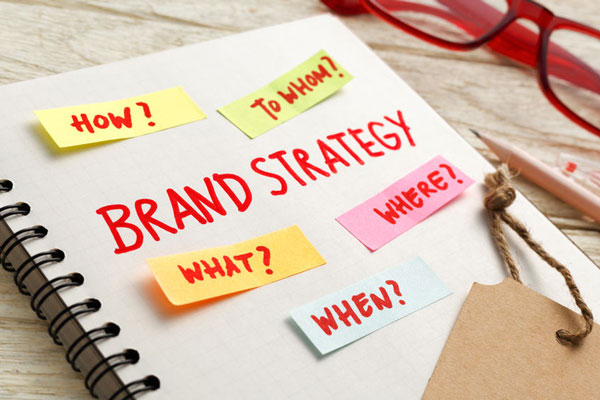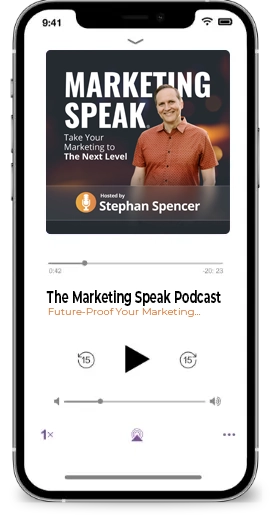If you run a business, you know that branding is more than just creating a logo. When done right, a brand represents your principles. It stimulates loyalty and aspiration in your customers and adds value in the marketplace. Above all, a brand is a promise. Many of you know that I’m a big proponent of branding done properly, yet this is only the third episode of Marketing Speak that we’ve ever done on this topic. My guest for this episode is Re Perez. Re is a leading branding expert and the Founder of Branding For the People, an agency that helps entrepreneurs and small businesses leverage the power of Fortune 500 branding techniques. In this episode, Re will be a guide on our deep dive into the nuts and bolts of an effective brand strategy, from typefaces and signifiers of luxury, to integrating your brand into your company culture.

Transcript
You’re about to gain an education in how some of the most influential companies in the world use branding to engage and inspire. If you’re interested in branding, make sure you read the other two excellent Marketing Speak episodes on this topic. Episode number 125 with Joana Galvao and episode number 69 with Brian Richards. I also recommend you to read my interview with Michael Port, which is episode number 24 on my other show, Get Yourself Optimized. It’s not a branding episode per se, but it is about how to present your best self when speaking in front of others. Michael is one of the best topmost speaker trainers in the world. If you’re a speaker who earns $10,000 per keynote and you want to get to $50,000, he’s your guy.
If you speak at conferences, in boardrooms, company functions, at family events or in front of prospects, you need his techniques. This is particularly pertinent for me right now because as I’m doing this, I’m in New Jersey at Michael Port’s headquarters going through his Heroic Public Speaking Graduate Program, which is incredible. Between my wife, Orion and I, we have made a mid-five-figure investment to go through HPS Grad and it’s already paying off. Speaking of investing in oneself, if you’re not already subscribed to Get Yourself Optimized, please do yourself and me a favor and subscribe right now. All in, I’ve invested seven figures in my personal development, masterminds, seminars, coaching programs and online training. I bring you the very best thought leaders and visionaries who I’ve discovered while on this journey. They’re all on Get Yourself Optimized. I do this for you for free. If you can think of a friend, family member or colleague who would benefit from the show, get them to subscribe to both shows. Re, it’s so great to have you on the show.
I’m excited to be here. Thanks for inviting me.
First of all, I want to know what your definition of branding is.
It is one of the most misunderstood topics. Most people refer to brand and branding as their logo or their website or they even say it’s synonymous with marketing. While branding is a marketing related discipline, it is distinct from marketing. The definition that I’ve been using and whenever I started an interview or I speak, I define these terms for people and the way that I’ve been trained to define brand is it’s a desired perception. Therefore, branding is a process and it’s a discipline designed to create the desired perception that you want to have in the marketplace. If that’s the case, you technically don’t own your brand. It resides in people’s minds. Your role in building a brand is to influence, shape and to get back that desired perception that you’re trying to create.
You’re saying you don’t own your own brand. It’s controlled or owned by the people in your fan group, your audience, and your constituents. That’s scary because people want to be in control of their own destiny. What do you tell people who are freaked out by this?
A brand is a desired perception. Share on XWhether you go through a branding exercise or not, we all form perceptions. Sometimes they’re instant. Sometimes they happen over time. We all form a perception of someone or something, whether it’s a company, a product or a service, whatever. We all form a perception by default. Know that that’s what’s happening on the other end regardless. When you go through a branding process, you’re a little bit more strategic with your intent to create the perception that you want. For those who like to be in control, this is putting one of those categories of there are certain things you can’t control. I can’t control the way that you perceive me. The only thing that I can do is to influence it or at least say things, look a certain way or behave in a certain way that would get the perception that I ideally want.
I like to use the analogy of if a guy walks into the middle of a room with a group of people and he says, “I’m the smartest person in this room.” The other people are looking at him like, “Who’s this jerk?” If a guy walks into the room and he says things in a particular way, he uses a certain vocabulary and he dresses a certain way. He knows more about the subject matter than everyone else in the room, then he derives the perception that he’s the smartest person in the room. The point is that people are going to form a perception of you regardless. You have to show up in a certain way and behave in a certain way to ultimately get the perception that you want.
What does this process look like of helping the audience to perceive what you want them to perceive, like setting the mood or the tone and stacking the deck in your favor?
It’s a multi-layered process. For simplification purposes, I’ll start with what I alluded to, which is if you think about it, there are many different ways to influence perception. I like to focus on three broad ways and I’ll use plain English because a lot of branders use fancy branding jargon. I always try to demystify things. I always try to talk in plain English so that people can grasp these concepts. What I started to allude to is what you say, how you look and how you behave all influence someone’s perception of you. On a practical level, when you think about whether you’re an entrepreneur or small business or even a larger enterprise is how you look. That’s your logos, your colors, your imagery, the photography that you’re using or even the typography that you’re using.
New York Times has a very specific typography and font than USA Today. They all convey a personality. How you look, for people who are thought leaders or experts or speakers or authors, how they dress, how they show up. The visual aspect influences people’s perception. There’s the verbal component, which is what you say and how you say it. Not just the actual words that you’re using but even the tone, the voice and the cadence in which you speak. That’s the verbal component. Then the behavioral is how you behave and how you act. Are you brash? Are you entertaining? Are you charismatic? There are a lot of different things that you can attribute towards a behavioral pattern and all of these things interact and create a perception.

If out of those three components, you’re focusing first on the look, I imagine you might want to do a mood board for example?
On the tactical level, yes. Even before the mood board, you want to define what’s this personality? What I do is very visual too. When you think about even the slightest word, luxury. Some people want to have a luxury brand. Not everyone has to have a luxury brand. That’s not what branding is about. You can be a mass-market brand, but let’s just take the word and pick that apart and say luxury. Luxury has many different flavors. You can be an uptown luxury, which has lots of blacks, gold, and sleek fonts. You can be more of a downtown hip luxury, which has more maybe lighter blues and lots of white. You can be an African safari luxury, which has a very colorful dynamic color system.
Even that one word, it goes back to what is the desired perception that we’re trying to create and put that into a language. One other piece of it that inform what you’re probing around is if you think of Harley Davidson, their brand promise. Their brand is about freedom on the open road. Then that gets assigned a set of attributes, values and personality characteristics. All of those two branding words is defining what is the desired perception that we’re trying to create? Then you would create a mood board for the look and feel of it. Then you would turn that into photos, images and font styles. You would create a mood board. From that, it becomes the basis for creating an identity. I say that more specifically than saying a logo because a logo is just a logo but a visual language and a visual identity are a bit more powerful. It communicates something much larger to your audiences so that if you were to strip away the logo, people can recognize your brand in marketing.
Do you have an example of a brand that is very much like that, other than Coca-Cola, where you can strip away the logo and it’s very obvious what the brand identity still is?
Burberry, they have the plaid. You can recognize that that’s a Burberry. I’m pointing to the luxury brands because that’s obviously very consumer-oriented. The LV for Louis Vuitton, people recognize that.
What you say and the tone in which you say it influences people's perception of you. Share on XTiffany, like the Tiffany box or bag.
There’s a whole business that is around going after trademark infringement where people are selling in New York Blue Boxes. People know that that blue connotes a certain feeling and Tiffany has owned that color blue. Even if it doesn’t have Tiffany, people associate that with a whole set of feelings that Tiffany has created in terms of an identity of having that Tiffany Blue Box. Those are a few bigger examples.
Sometimes that visual identity gets in the way of being able to search engine optimize the website. I had this challenge when I was working with Chanel that their brand guidelines and the rules that they had to work around didn’t allow them to add hardly any textual content to the web pages. How am I supposed to optimize web pages that have no text on them so that they ranked for what? That’s very challenging. That was frustrating. What do you suggest in that kind of scenario?
I always like to start to say this because of my background prior to going on my ninth year in business working with entrepreneurs, small and midsize businesses, I did a brand, which is one of the largest global branding firms. I worked on these big brands and they have massive budgets to be able to do some cool things and whatnot. When you’re working with a smaller enterprise or I wouldn’t even say that I would actually even say now, it’s more important to have a great balance of great branding, great design, great marketing, and great social media. They all interplay with one another.
Because it looks nice, unless you’re telling me that you have $1 billion marketing budget, then sure, don’t worry about SEO or optimizing a website. The game of business now is to have all of them interplay with one another. It’s not just about making things look pretty, it’s about also having them be functional, having them be conversion-oriented and having it do what it’s intended to do. I think there’s a balance. Going from one extreme to the other is not the way to go. It’s integrating all of these different disciplines.

We’ve talked a bit about the look. There’s also what you say and how you say it piece and then the behavior, which includes charisma and all that stuff. Let’s talk about those other two components.
I’m going to reference bigger brands because people can identify that in their minds. If you think of JetBlue or Virgin America, they speak in a different way than Delta or United or even Southwest. They’re all airlines, but they all use a certain vocabulary. One is a bit more conservative. One might be a little bit more playful or tongue and cheek. Even the language that you use and on a more tactical level, even for some marketers who are using email copy or even social media posts. Are you greeting your subscribers with, “Hello friends,” or “Hey there,” or “Hey, yeah?” Being tactical versus just to get my point across is that there are different ways to say the same thing. Sometimes two things can happen when you dial in your brand when it comes to verbal and copy.
One, you’ll say things in a way that it’s true to your personality and then two, you might even do a little pattern interrupt because most people are used to seeing the same type of copy over and over. I come across some of these examples all the time where I’ll sign up for a newsletter or I will purchase something. I’ll give you one good example. I got an invoice receipt, a paid receipt from a company that I had hired. Rather than just getting a plain old email receipt saying that I’ve paid my invoice, I got a mini video where someone was like, “We appreciate you. Thank you so much for paying your invoice on time.” It was so outside of the box that I had to open up the email or I had to read it because it was so engaging. It was a little bit of a pattern interrupt. That was true to this company’s personality. They are about relationship. The way that you speak and what you say and the tone in which you say it influences people’s perception of you.
That tone and the way that you speak shows up in print. It shows up on billboards or in magazine ads and so forth. It shows up digitally on your website and your email, copy and it shows up in your employees talking to the customers. Like Southwest, there’s a certain style where the flight attendants will get videoed while they’re giving their funny and entertaining safety demonstrations and then those will go viral. That’s something that doesn’t really happen on United.
One other thing, depending on who’s listening in. If they’re a service-based professional or let’s say someone who has a lot of speaking or that’s an influencer, the way that you speak on stage is another way that can influence perception. I always say that when you get true to your brand, how you speak on stage has a perception and it has to be authentic. It would be completely inauthentic if Oprah Winfrey came out and started cursing like Gary Vaynerchuk. It would be completely inauthentic. How you speak and the tone that you use should match your brand, should match your personality. It’s not just in print, it’s also in how you speak.
Behavior cuts across both what you say and how you look. Share on XI’m guessing that you’re not dropping F-bombs everywhere when you’re on stage.
Not on stage. I wouldn’t be opposed to it, but that’s not my expression to communicate my point. I don’t need to use those types of things to communicate a point.
It certainly would be a pattern interrupt if people aren’t expecting that from you based on your brand perception and then you drop an F-bomb in the middle of the presentation. That would be surprising.
Sometimes when you watch people and then suddenly they started dropping an F-bomb, I don’t know about you but for me sometimes I could tell because I’m so observant of this, when someone is using a vocabulary inauthentically. It’s almost as they’re using it as a gimmick to grab attention. You’d know or maybe you don’t know, maybe you just feel it that that’s not part of their brand. It’s a marketing gimmick or a ploy to grab attention. If you’re the type to use an F-bomb or not, make sure it’s true to your brand.
For Tony Robbins or Gary Vaynerchuk, no problem. You can expect it but not out of Re probably. Let’s talk about the behaviors. What charisma and style in what you do can you bake branding into? What would be maybe some big brand examples that we might have heard of or experienced?

The truth of the matter is that behavior cuts across both what you say and how you look. They all interplay with one another. If you think of Nordstrom and I know a lot of other department companies have adopted this behavior, but Nordstrom was the first. When you make your purchase, they take your bag and they walk around the counter and hand you your purchase. That’s a behavioral component that is so subtle yet it’s part of their brand experience. I haven’t flown with Singapore Airlines, but I remember reading a case study on it where a big part of their brand experience is that rather than looking down at you, they kneel down and looking at you eye-to-eye. That’s a behavioral component that is like, “We’re together.” It is a bit more inviting and friendlier. These are subtle cues. Certain behavioral things in terms of experience in retail environments where they offer you tea or wine or a cocktail or something to have it be a bit warm and inviting.
Like the DoubleTree hotels, when you go and they give you a cookie when you check in.
These are their signature things that you expect or you look forward to that is part of their brand experience. That’s what I’m saying when I’m talking about how you behave is what’s the experience. I know that we all know this quote, “It’s not what you do for people, it’s how you make them feel.” It’s more than the act or the behavior, it’s what does that act or behavior and how does that make people feel? That’s what you want to go through is how do you make people feel through your behaviors? For smaller businesses, it’s like if you’re putting on an event, how do you make people feel at your event? Even in marketing, how does your website behave? It’s not a physical action like an in-person retail action but does your website behaves in a way that it makes it easy and smooth for someone to navigate or is it complicated? Do we make it hard for you to find your phone number to contact you like Google? Do we make it super easy for you to contact us?
When you are in contact with the feeling that you get in terms of, even if you can’t put your finger on exactly the behavior that they’re doing, kneeling down to talk to you or whatever, but you know that you’re going to be looked after. Like Zappos for example, they are customer-centric to the nth degree. I’ve had the pleasure of working with them for several years. They’ve been a client on and off for multiple years and they have been a joy to work with. That culture is throughout every part of the business. It’s not just the customer service department.
That’s a good point because I went on a tour at Zappos with the entrepreneur group that I was a part of. I remember you could see it embedded in every part of their culture. In fact, they don’t even have, I don’t know if they’re still doing this, but the holacracy, this non-hierarchical approach to their culture. You could feel it when you walk in there that there is no hierarchy or there are no cubicles. It’s like an open concept culture.
It's not what you do for people. It's how you make them feel. Share on XIt’s very inviting. Even before they instituted holacracy, that culture was throughout the organization. I too have had tours of their offices multiple times. It’s so fun to get greeted in this clever, fun and outside-the-box way. Some section will have the big sombreros and the shakers. When the tour group comes by, that would be the section that greets you with a Mexican-style welcome. Then you go to a different section and they greet you in a completely different way. It is really cool. There’s so much personality there.
I thought to myself when I was doing a tour, I was like, “If I ever work for a company again, like a big company,” it was that inviting that I was like, “I think I should work here,” but I don’t think I’m the target audience. There are lots of Millennials and lots of younger talents.
What else they did and I don’t know if they still do it, but I was impressed by it. They had books at the front entrance area. You help yourself to whichever books you want to take home. They’re all free and they’re not just books written by Tony Hsieh or other Zappos people. They’re favorite books of the executives and help yourself. That’s so cool. Did you end up taking a book?
I did not but they gave us a book on their culture. It was a hardback book that’s more like a coffee table type book that was in detail about their culture. I was traveling light so I didn’t take that many books. I was like, “I’ll just buy it.”
It’s that inviting a generous brand positioning that they are conveying that isn’t just like, “We’re customer-focused but we believe in sharing the wealth, sharing the knowledge, upscaling and getting better all the time.” They didn’t say that anywhere. They didn’t speak it. They didn’t write it. It wasn’t in any look or typography or anything like that. It was in the behavior that I got that feeling.

That’s an important point because rather than it being lip service and anything that you do from a cultural perspective or a customer experience perspective, it’s one thing to say that you’re customer friendly or it’s one thing to say that you are employee-focused. It’s another thing to have that be part of your DNA and have it be real. Sometimes it’s better to behave on those things that you believe in rather than just touting it.
What would be an example of a company that just pays lip service to the brand that they’re trying to convey?
You want me to throw some companies under the bus?
If you’re okay with that.
I would say broadly speaking, this happened a lot when I worked with some of the bigger companies when we would work on their company values or their brand values. I have had a lot of experience with that where it seemed to like lip service. That’s a big part of what I did when I worked at bigger firms is not just brand strategy, but looking at the culture of the company. Even though I studied design, initially my degree is in Organizational Behavior and Communications. I rose up the ranks and branding in a slightly different path because I looked at things not just from a design perspective but from a cultural and behavioral social sciences perspective.
Sometimes it's better to actually behave on those things that you believe in rather than just touting it. Share on XMy point is that I would interview employees, particularly the frontline staff and there was always a big disconnect between what actually is happening in practice and what the company says or they espouse that they believe in and trust. However you want to categorize that, it’s more a matter of I have seen it, I’ve experienced the disconnect. I will always push for clients, even for smaller enterprises. If you’re going to say something that you believe or that you value, then have that be part of the way that you were award employees, the way that you compensate them, the way that you develop them. That there are some specific things in the culture that embody what you’re saying so that it no longer becomes just lip service.
I’m going to throw a company under the bus here. I’ve been a longtime customer of United. I’ve collected hundreds and thousands of miles with United over the years. I didn’t want to give up my status because I was gold at the time, but when they mistreated that passenger and it was caught on video and he got socked in the nose and stuff and he’s bleeding and dragged out. They have no right to treat a fair paying customer that way. I thought, “I’m not going to do business with these guys,” and then I ended up still flying on them. Not as much as I used to but I still have status with them. I have a status also at Delta now too, but that rubbed me the wrong way. A lot of people got up in arms about it and I know there was a firestorm on social media about it. What are your thoughts on that whole United fiasco?
Similarly, I’m definitely more of a Delta person. I hate flying United. I don’t know why but the experience in and of itself. Regarding that fiasco, I think it’s all the same things you mentioned. I would not invest my money with a company that that’s how they treat their fair paying customers. This is where you looked at social media. It’s good that there’s a voice being heard to that because I don’t know when I would have otherwise heard of that story other than if it made the news. There’s something in the culture of that company you could say or maybe that particular flight or flight attendant, I don’t know. There’s something in that that would even allow for that to happen. That’s non-negotiable. Why would you treat your customers that way?
I think it’s endemic within the company, within the whole culture. I’ve seen a lot of surly employee behavior over the years with the United staff. Not necessarily to me, I’m in line and they lose their temper or they’re short with a customer who’s clearly frustrated and is not in their best behavior either but that doesn’t mean that you can let loose.
You have more experience. I haven’t flown them that much anymore.

Let’s talk about how you can go from strategy to tactics in this whole brand perception thing. You know the personality that you want to convey. You know how you want your staff to behave and what you want to say whether it’s on stage or at a trade show booth or it’s in a podcast interview or whatever. You want that to be conveyed tactically in everything that you do. How do you connect the dots?
My response to that first starts with it is magical when people get clear on what their brand is and what it’s not because those inevitably guide your decisions on a tactical level in terms of “This is on brand or off brand for us.” This happens a lot. I have one client in particular, I’ll tell briefly his story. We would go to our web designers or our in-house design team. They’re like, “Let’s come up with some new lead magnets. Let’s create a new funnel.” They would come back with these designs that were ‘70s disco. Then they’re like, “No, that’s not it.”
It was something that had a different look and feel. I can’t recall at the time. The point was they kept going through endless rounds of revisions because they weren’t clear on their brand. They were throwing up different ideas against the wall to see if they would stick. When they went through the branding process and got clear on who they are and who they’re not, it made it easier for them to go to one-off designers and saying, “Here’s our brand, here’s what we’re about and here’s our personality. Go and create a landing page or a lead magnet.” It actually made the designer or the copywriter’s job easier because now they have some direction. I want people to hear that piece of it is that it is important to define your brand first before moving into the tactics.
More specifically, let’s take a website for example and this is where the balance of great marketing, online marketing, design, and UI/UX strategy, all these interplays. If you go to the landing page of a homepage, and you and I both know that on average people spend less than fifteen seconds on a website. How can you capitalize on that first fifteen seconds? Is there the right hierarchy of information? Is there a singular call to action? Is it telling your viewers and your cold traffic what you want them to do? Is there a clear message of who you are? Can people understand that they’re in the right place within that first fifteen seconds? Is it visually appealing to your audience? That’s important.
You could be high-end or you can be mass market but has it the right look and feel that instantly grab someone’s attention, tells them who you are and what you do, and then why they should be on this page and what the call to action is? It is, when you define your brand, you can look at that on a tactical and say, “My website does or does not do that.” That applies to every other thing but it is not to beat a dead horse stuff and that’s the point, the tactics are easier when you get clear on the strategy of your brand.
A lot of folks are ineffective in conveying that brand personality. They might send a PDF of their style guide over to the company they’ve hired to write the copy or do the web design or do business cards or whatever for them. They hope that they look that over and understand what they’re trying to achieve strategy-wise by reading some slick looking style guide PDF. What’s an effective way to do this versus that ineffective way or even worse send them no information? Just say, “Here you go, here’s our font.” There’s no style guide even.
Some will say, “Make this look cool or make this look pretty or make this look professional,” because professional is not a personality. What you want to give a creative person is what’s the essence or what’s the personality of this brand so that they can then do their best work? Then you marry that with what is the objective? What are we trying to accomplish on a website or a landing page or whatever the vehicle is? What’s the desired outcome that we want? You have to marry all the strategic thinking with the outcomes that you want. You can’t go to a designer and say, “Make this look corporate.”
You have to give them some elements or attributes of what you’re trying to convey. There’s probably a term that most people don’t use and I’m sure you get it, but it’s like giving a designer or a creative team, a creative brief. As simple as one page of creative brief saves you a lot of time because that’s the direction. Creatives need direction. I will tell you, on the flip side, in response to your question is what you shouldn’t do. What you shouldn’t do is design by committee. That’s probably the worst way in my mind to get some output is having a bunch of people approve or vet certain designs. There’s got to be one person spearheading and leading the way when it comes to design and making sure that it’s true to the brand. Then other people making sure that they’re reinforcing or enforcing that overall strategy. I’m against design by committee.
A brand strategy should fulfill your business strategy. Share on XHave you heard the expression, “A camel is a horse designed by a committee?”
Yes. Similarly too, one of the things that’s truly annoying is when you’re on social media and someone’s posting, “What do you think of my logo or book cover or jacket?” You’re asking a wide range of people who have no clue what your strategy is and what’s the desired perception you’re trying to create and people who don’t understand design. You’re asking their opinion on what your branding should look like or feel like when they may not be your target audiences. I’ve worked on some brands where the look and feel or the visual identity isn’t necessarily my style, but it doesn’t matter because I’m not the target audience.
I may not like it. Some designers will give you like, “This looks cool or this looks high-end,” or this looks whatever. Whatever the style that the designer might want, that is an inappropriate way to build someone’s brand. The brand should always be directed towards the target audience, who are you trying to attract? The reason why I’m against design by committee or even posting on social media asking for a bunch of strangers or your friends and family members and whatnot about what they think of your branding, is that you first have to then brief them on all the strategic thinking of what you’re trying to create, the desired perception that you’re trying to create. If you don’t do that, you’re shortchanging your opportunity. You’re basically assembling a bunch of things based on what people like or don’t like and they may or may not be your target audience.
Let’s say for the sake of argument, it is your target audience and you’re doing a poll on Facebook. I had this conversation with a friend of mine who was a guest on my other show. I won’t spill the beans on who he is. I’m giving him a hard time because I don’t think he should be listening to his current customers on this important branding decision. He’s asking whether he should rebrand to a more overarching brand that would fit other styles of online courses or if he should keep it to this very narrow niche brand that he’s got as one course or set of courses under. I’m like, “This is not the right audience for you to be asking this. They don’t understand the brand and they don’t understand branding. They are already acclimated and used to your existing brands. They’re going to favor that because they’re used to it.” Of course, they said, “Just keep this brand, it works.” They didn’t give the detail. On a poll, they chose which one of the two, this brand, the current brand or this new brand that is more versatile. Hardly anybody chose the versatile one. I’m like, “You need the versatile brand because you’re going to create an empire here. You’re going to be the next Lynda.com.” Let’s hear your reaction.
I talk about branding a desired perception. What you were describing is basically a process where you’re asking people, “How do you think that I should be perceived?” versus it coming from you, the business owner or the entrepreneur like, “Here’s how I would like to be perceived.” Asking even your target audiences, “What do you like or what do you don’t like?” We all know that most human beings don’t like change and they are comfortable with what they know. If you’re only looking within the sandbox of what’s comfortable and what people know, then you’re limiting your opportunity for what you can do with your branding.
The second part that you mentioned is that they might not be privy to your business strategy. A brand strategy should fulfill your business strategy. If they want to be more enterprise or they want to be more global or they want to branch out into different markets, asking just one audience set, maybe the new audiences that you’re trying to attract, what they think of your branding is also compromising the depth of how you can build out your brand. You haven’t given them your business strategy. You’re doing things by default rather than with strategic intent. That’s the biggest thing that I want to convey when it comes to branding. You have a strategic intent towards creating a perception as opposed to letting the market dictate how you should be perceived or why it should be perceived in a particular way.
Let’s say that you have a style guide or you have even better, a creative brief for the designer, the copywriter or whoever, but you’re not sure if it’s good. Do you have any examples that either you could share from your agency’s work with clients or maybe you found these examples online? I’ve found plenty of style guides online that are public for anybody to download. I’m curious what would be an example or two that people could download and compare and contrast what they’re doing, if anything, to what these best in class examples are doing?
Those are two different things, style guidelines and then a creative brief. Let me first start off with a creative brief. I can give some examples or some best practices when writing a creative brief. One you should have a set of three to five creative criteria from which you would evaluate the design. I’ll give some examples, but when people go through this process, it has to be true to their brand. It’s not a matter of, “I like that one. I should include that one.” That always happens when you give too many examples but in terms of the best practice, it’s like, “How should we evaluate this?”

One example of creative criteria is that it should appeal to both men and women or it should appeal to a twin audience. It should appeal primarily to women or it must look like a global brand or has a feeling of a global enterprise. There are different sets of nuances that you would go through in creating a global brand, versus it must appeal to local grassroots or set of an audience if you’re just targeting one particular thing. Sometimes you don’t want to be perceived too big when you’re trying to be local and sometimes you don’t want to look too local if you’re trying to be more enterprise. Those are some examples of you have to have a set of criteria.
Then you have to give some direction around colors. Most people haven’t studied color theory and color psychology. You either want to tell the creative person, and I’m talking specifically with visuals, “I’m open to all colors or I absolutely love or absolutely hate certain colors. I hate pastels or I love pastel colors. Or I hate primary colors.” You can give some of that direction in terms of your own design preferences. The same thing when it comes to logo types. There are different types of logos. Do you want something that’s more typographic-driven or something that is emblem or symbol-driven or something that’s a combination? Giving them some direction in that creative brief so that you can narrow down the brainstorming process. Then give them some exemplary brands in your creative brief.
For example, and this is where you’re very specific when it comes to visuals like, “I like the Nike brand or I like the Patagonia brand,” and then explain why. Not just the logo but like, “I like the photography in Patagonia or I like the edginess,” or whatever the attributes are. Give some examples to help visualize it for the creative person. When it comes to brand guidelines, Nike’s brand guidelines are probably 100 or 200 pages. Most small businesses probably don’t have the same level of guidelines because they don’t have that many applications as Nike. You can google brand guidelines online. Most guidelines are geared towards a designer, which is how to use the logo? How not to use a logo? What’s the minimum space? How can you crop it or scale it? What are the things that you can’t do? They’re very specific to how to use a logo or what are the color palettes?
When you have a full brand guideline, some of the best practices is to also include some of the strategies like; who are we? What’s our story? Who are our target audiences? Not just how we need to look but also what’s our voice? Giving some examples of, “We say this, instead of this.” Some do’s and don’ts around language, maybe even some guidelines around the types of words that are not in your vocabulary. For example, a company might say, “We never use the word, free. We always use the word complementary. We never refer to small, medium or large. We say tall, venti, grande.” Give them some guidelines around the language that you use. Then finally, making sure that everyone who’s looking at this document can find themselves or find some utility in this and what does this mean in terms of our culture, behaviors, beliefs and value systems? How does it play out in giving people some examples of how to act on the brand? In my mind, that’s a more complete brand guideline as opposed to style guidelines.
A great distinction there and an important and even bigger distinction our audiences need to get is that guidelines are not a brief. If you’re getting somebody a brief, you’ve thought through this particular project’s requirements the aspirations, goals, and objectives for that person or that agency to execute on this particular project. Brand guidelines are overarching and it might be overwhelming like in the case of Nike, hundreds of pages, they’re probably not going to sift through all that to try and figure out what to do. They might just skim it. Whereas if you give them one or two-page creative brief, you’ve distilled it down to enough information they need and not overwhelm them.
One other point that I would say on that topic to put a wrapping on that for me is that they’re guidelines. The reason why they’re called guidelines is you don’t want to prohibit creativity or being adaptable to the market place. You want to be able to put forth a set of guidelines, not rigid standards. I want people to hear that correctly. It’s not that you could just do anything with the logo, for example, but you might want to take a look at all the tools in the toolbox and look at the specific communication or marketing vehicle that you’re looking at. You’re like, “How can we convey and still be consistent with the brand on this particular marketing channel?” That’s what I’m saying is that consistency trumps sameness when it comes to creative and design. It’s not about a matter of having everything look the same, it’s about having everything look consistent with your brand such that you’re creating a brand language across all your different touch points.
A business solves a problem for a particular audience. Share on XThere’s an expectation that your customer base has that they’re going to feel a certain way when they’re interacting with your brand. You mentioned color theory when we were talking about style guides and creative briefs. Could you define color theory? I know it’s a whole discipline and I’m sure we could end up talking for a long time about it. I know we don’t have time to do that, but could you give us a definition? What would our audience need to know about color theory in order to hire the right people to get the colors right?
That is a big topic. It’s probably an interview in and of itself, but in the time that we have, here’s what I want people to understand around color theory and color psychology. Unless you studied design and looked at the color wheel, there are certain colors that go better with others. There’s probably a way to define your primary colors and your secondary colors. One of the top three questions that I get is what should the color of my brand be? It’s a very interesting topic because people want to know what it should be, but when you get clear on your brand, it helps it to inform the types of colors that you should use. My point is that if there’s one thing that I want someone to get around this whole topic around color is that color is not devoid of context. You can google color psychology online and a lot of it gives you broad strokes like blue conveys trust and safety. If you don’t look at the context for that, then maybe you might say, “I should use the color blue.”
If you were to make a gun or knife, does blue make it less safe? No, it’s still a gun or it’s still a knife. You have to look at the context in relation to color. Red, for example, is often associated in the financial industry as the negative. If you were to rule out red from your color palette, then we would have things like Bank of America or if you’re only told that you’re only supposed to use blue in the financial industry, you wouldn’t have a TD Ameritrade or TD Bank that uses green. You have to look at context when it comes to color. It is important to look at the color and it’s more important to look at the context in which you’re using the color and what your brand stands for. For example, going back to the Bank of America, if their brand is about being different, then they’re picking a color that is historically against what they should be using in the finance industry, but they’re picking a color that is representative of their brand.
I want our audience to have some action steps for them to take because I’m sure they’re excited about having a proper creative brief. What would be some action steps for our audience to take that’s not overwhelming and not beyond their capabilities? They’re not going to create their own brand guidelines, for example. They’re not going to do a proper survey of their target audience to get what the ideal or what the current perception of the brand is and so forth. They need to hire experts to help them with these different things. What would be some things for them to do?

I always start with this because this is the starting point on any branding exercise. Whether you’re hiring someone or you’re doing it internally or you’re getting your ducks in a row to think about embarking upon a broader branding exercise. It goes back to something that intersects between business, branding, and marketing. That is getting clear on your who, what and why. What I mean by that is, who are your target audiences? What are the problems that you’re solving for them? Why should they listen to you? Why should they believe you? Why should they buy from you? While they pose questions and whether you relate to it as strategy or tactics or whatever, anyone who’s in this conversation of being able to inform their visuals or their copy or their marketing, make sure that you first start with understanding who you’re targeting? What’s the problem you’re solving for them and why should they listen to you?
If you can’t answer those three questions, then you’re stepping over a foundational piece and all the other tactical expressions and tools that you can use to building your perception in the marketplace. Your perception should be informed by understanding who are you trying to create a perception for. Then when I say the problem, I think about the value that you’re bringing to that audience and then thinking about how are you going to differentiate yourself compared to all the other people that are solving that same problem?
Essentially, if you as the audience cannot articulate the who, what and why for your audience and your brand, you’re too early to start getting a mood board created or brand guidelines or style guide or creative brief or any of this.
That’s why I said it’s foundational to business because a business solves a problem for a particular audience. That’s why it overlaps between understanding your business and your brand before you go to market and building a website.
Re, this was awesome and very enjoyable and very informative. If our audiences want to work with your agency and with you, how would they get in touch?
It’s always good to check out some of the complementary stuff that we have on our website or even just more in depth of how our philosophy around branding. It’s BrandingForThePeople.com. There are lots of great free complementary resources. If it made sense to at least engage in a conversation, there should be one of the buttons on there to schedule a complimentary call with my team.
Re, thank you so much. This was fantastic. To our audience, go take some action. This is stuff that is all very interesting and there’s no ROI in just passively reading to this. You’ve got to get off your butt and do something with it. Go check out Re’s website and take some action with your business.
Important Links:
- Branding For the People
- Joana Galvao – Previous episode
- Brian Richards – Previous episode
- Michael Port – Previous episode of Get Yourself Optimized
- Heroic Public Speaking Graduate Program
- Re Perez
- Lynda.com
- BrandingForThePeople.com
- Get Yourself Optimized
- New York Times
- USA Today
- Harley Davidson
- Coca-Cola
- Burberry
- Louis Vuitton
Your Checklist of Actions to Take
☑ Understand what branding means. Branding is not my logo or my website. It’s a discipline designed to create the desired perception that I want to have for my business.
☑ Know the three components that affect people’s perception of my brand: visual, verbal and behavioral.
☑ Create a mood board as a basis for creating an identity for my brand. It will help make my visual language and visual identity resonate with my audience.
☑ Balance my efforts between branding, design work, marketing, and social media. They must interplay with each other so that I can maximize their impact on my business.
☑ Be authentic. My verbal language and tone must match my brand and personality because the way I speak can influence people’s perceptions.
☑ Know how to behave according to my brand and know how that behavior makes people feel because the way I behave reflects my brand experience.
☑ Apply this branding exercise, “Who is my target audience? What are the problems that I’m solving for them? Why should they listen to me?”
☑ Revisit episodes with Joana Galvao and Brian Richards and find golden nuggets and strategies into effective branding.
☑ Check out Stephan’s interview with Michael Port on Get Yourself Optimized and learn how to present my best self when speaking.
☑ Take action now and connect with Re. Make sure to visit BrandingForThePeople.com for some complimentary material or for a deep dive into his philosophy around branding.
About Re Perez
 Re Perez is a seasoned Brand Consultant, Keynote Speaker, and the CEO and Founder of BRANDING FOR THE PEOPLE, a leading branding agency that helps entrepreneurs and small-to-midsize businesses create memorable and profitable brands by leveraging the power of Fortune 500 branding. Global clients include emerging entrepreneurs, Inc. 5000 fastest-growing companies, and established multimillion-dollar businesses.
Re Perez is a seasoned Brand Consultant, Keynote Speaker, and the CEO and Founder of BRANDING FOR THE PEOPLE, a leading branding agency that helps entrepreneurs and small-to-midsize businesses create memorable and profitable brands by leveraging the power of Fortune 500 branding. Global clients include emerging entrepreneurs, Inc. 5000 fastest-growing companies, and established multimillion-dollar businesses.








Leave a Reply